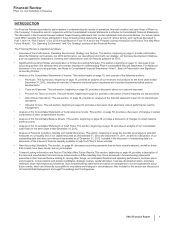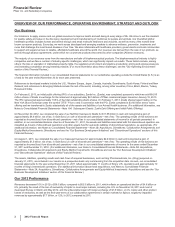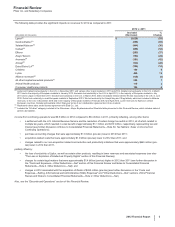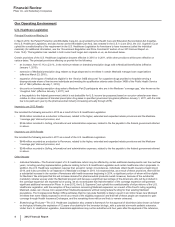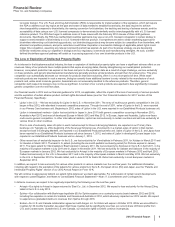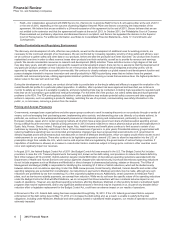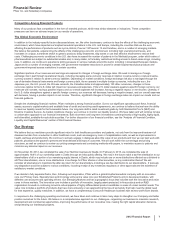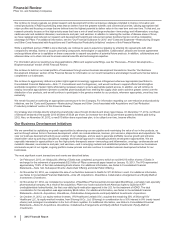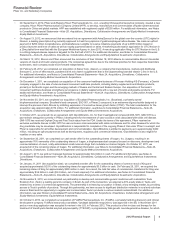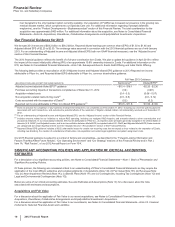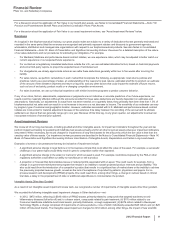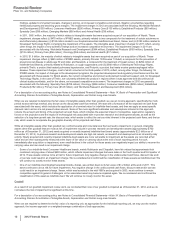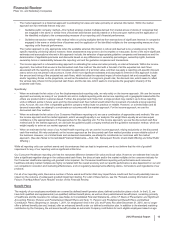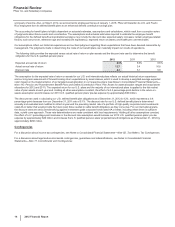Pfizer 2012 Annual Report Download - page 5
Download and view the complete annual report
Please find page 5 of the 2012 Pfizer annual report below. You can navigate through the pages in the report by either clicking on the pages listed below, or by using the keyword search tool below to find specific information within the annual report.
Financial Review
Pfizer Inc. and Subsidiary Companies
4
2012 Financial Report
Our Operating Environment
U.S. Healthcare Legislation
Principal Provisions Affecting Us
In March 2010, the Patient Protection and Affordable Care Act, as amended by the Health Care and Education Reconciliation Act (together,
the U.S. Healthcare Legislation, and also known as the Affordable Care Act), was enacted in the U.S. In June 2012, the U.S. Supreme Court
upheld the constitutionality of the requirement in the U.S. Healthcare Legislation for Americans to have insurance (called the individual
mandate) (for additional information, see the “Government Regulation and Price Constraints” section of our 2012 Annual Report on
Form 10-K). This legislation has resulted in both current and longer-term impacts on us, as discussed below.
Certain provisions of the U.S. Healthcare Legislation became effective in 2010 or in 2011, while other provisions will become effective on
various dates. The principal provisions affecting us provide for the following:
• an increase, from 15.1% to 23.1%, in the minimum rebate on branded prescription drugs sold to Medicaid beneficiaries (effective
January 1, 2010);
• extension of Medicaid prescription drug rebates to drugs dispensed to enrollees in certain Medicaid managed care organizations
(effective March 23, 2010);
• expansion of the types of institutions eligible for the “Section 340B discounts” for outpatient drugs provided to hospitals serving a
disproportionate share of low-income individuals and meeting the qualification criteria under Section 340B of the Public Health Service
Act of 1944 (effective January 1, 2010);
• discounts on branded prescription drug sales to Medicare Part D participants who are in the Medicare “coverage gap,” also known as the
“doughnut hole” (effective January 1, 2011); and
• a fee payable to the federal government (which is not deductible for U.S. income tax purposes) based on our prior-calendar-year share
relative to other companies of branded prescription drug sales to specified government programs (effective January 1, 2011, with the total
fee to be paid each year by the pharmaceutical industry increasing annually through 2018).
Impacts to our 2012 Results
We recorded the following amounts in 2012 as a result of the U.S. Healthcare Legislation:
• $593 million recorded as a reduction to Revenues, related to the higher, extended and expanded rebate provisions and the Medicare
“coverage gap” discount provision; and
• $336 million recorded in Selling, informational and administrative expenses, related to the fee payable to the federal government referred
to above.
Impacts to our 2011 Results
We recorded the following amounts in 2011 as a result of the U.S. Healthcare Legislation:
• $648 million recorded as a reduction to Revenues, related to the higher, extended and expanded rebate provisions and the Medicare
“coverage gap” discount provision; and
• $248 million recorded in Selling, informational and administrative expenses, related to the fee payable to the federal government referred
to above.
Other Impacts
• Individual Mandate—The financial impact of U.S. healthcare reform may be affected by certain additional developments over the next few
years, including pending implementation guidance relating to the U.S. Healthcare Legislation and certain healthcare reform proposals. In
addition, the U.S. Healthcare Legislation requires that, except in certain circumstances, individuals obtain health insurance beginning in
2014, and it also provides for an expansion of Medicaid coverage in 2014. It is expected that, as a result of these provisions, there will be
a substantial increase in the number of Americans with health insurance beginning in 2014, a significant portion of whom will be eligible
for Medicaid. We anticipate that this will increase demand for pharmaceutical products overall. However, because of the substantial
mandatory rebates we pay under the Medicaid program and because a significant percentage of the Americans who will be included in
the coverage expansion are expected to be young, we do not anticipate that implementation of the coverage expansion will generate
significant additional revenues for Pfizer. In June 2012, the U.S. Supreme Court upheld the constitutionality of all provisions of the U.S.
Healthcare Legislation, with the exception of the provisions concerning Medicaid expansion; as a result of the Court's ruling regarding
Medicaid, states can choose not to expand their Medicaid populations without losing federal funding for their existing Medicaid
populations. The Congressional Budget Office estimates that the new state flexibility is likely to result in six million fewer new Medicaid
enrollees than were initially expected to enroll as a result of the eligibility expansion and that half of these people are expected to gain
coverage through Health Insurance Exchanges, and the remaining three million are likely to remain uninsured.
•Biotechnology Products—The U.S. Healthcare Legislation also created a framework for the approval of biosimilars (also known as follow-
on biologics) following the expiration of 12 years of exclusivity for the innovator biologic, with a potential six-month pediatric extension.
Under the U.S. Healthcare Legislation, biosimilars applications may not be submitted until four years after the approval of the reference,


